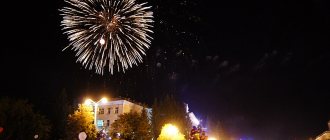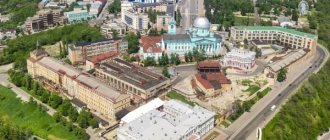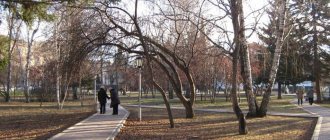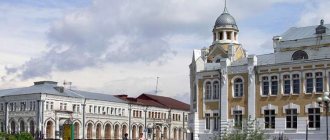In the southeast of the West Siberian Plain there is an amazing and picturesque region. Its past is covered in legends and traditions, and the land still hides secrets and mysteries.
The Novosibirsk region is one of the most hidden areas of the Siberian land. Although 5 of the territory is covered with forest, there is enough space for both small villages and large cities. The cultural, historical and industrial center of the region is Novosibirsk. The history of the region and its capital is reflected in historical and cultural monuments, unique collections of numerous museums.
Novosibirsk State Academic Opera and Ballet Theater (NSATOiB)
Novosibirsk State Academic Opera and Ballet Theater
Address: Novosibirsk, Krasny Prospekt, 36
The theater building is not only one of the main cultural and architectural monuments. It first opened its doors in 1945 after the end of World War II, although construction began back in 1931. Until that moment, unique exhibits from the Hermitage, the Tretyakov Gallery and other masterpieces of art were stored inside the unfinished building.
The Opera and Ballet Theater is shrouded in many secrets. The most famous legend is that under the building there is a real underground city, which includes 5 levels. But the rumors were not scientifically confirmed, remaining only a beautiful mysterious story.
Inside the building, antique statues deserve special attention, capable of sending visitors back in time for a few minutes. The interior is not sophisticated or complex, but it looks very elegant. Huge crystal chandeliers shed light from the ceiling. But the greatest delight is caused by the huge dome towering over the building and the bright flickering lights that illuminate the theater at night.
The Novosibirsk State Academic Opera and Ballet Theater is located on the central square. Its size is amazing and attracts the attention of tourists passing by. You can notice the building on many souvenirs and postcards, because the theater is considered one of the calling cards of the city. The theater's repertoire includes many famous productions, both Russian and well-known foreign directors.
Novosibirsk
How many monuments are there in Novosibirsk? If you believe Wikipedia, then quite a lot, but virtuality does not always keep up with reality. In this metropolis, interesting compositions that are an expression of the creative potential of local artists appear quite often.
It’s not for nothing that Novosibirsk is considered the third largest city in terms of population and the twelfth largest city in the Russian Federation.
So let's begin our sightseeing tour.
House-Museum of P.P. Bazhova
Address: Novosibirsk region. With. Bergul, st. Central, 29
The famous Ural storyteller stayed for several months (March-June 1919) in a small village in the Novosibirsk region. Here he not only rested his soul, sought inspiration for writing new works, but also became the first teacher at a local school. In memory of P.P. Bazhove native. Bergul - A.M. Belova began to found the museum. The grand opening took place in January 1984.
The interior of the main halls is designed based on the fairy tales of P. P. Bazhov. The decorations are made using malachite and mosaics. One of the rooms is equipped with a writer's office. Here you can see the table at which Bazhov worked, a hanging mirror and an antique cabinet. The walls are hung with memorable photographs of the writer, books published in different years, letters from the writer and his students are displayed on the shelves. Among them there are several unique specimens, preserved in the singular. In total, the collection of the house-museum includes more than 2 thousand exhibits.
Every year, museums host “Bazhov Days” - events dedicated to the birthday of the Ural storyteller.
The exhibition dedicated to the writer is not the only one: 3 more interesting exhibitions are open in the house-museum:
- Agricultural tools for processing flax and hemp;
- Stove corner;
- Household items of the 19th – 20th centuries.
Immortalized traffic light
The traffic light monument in Novosibirsk was built for the seventieth anniversary of the traffic police, and one of the authors of the project was the head of the regional department.
It is believed that this sculpture symbolizes the transition of control over the situation from humans to modern technology.
This monument was erected in 2006 near school No. 12. This is the oldest educational institution of this type in the city, and the first traffic lights were placed exclusively near schools to protect children from reckless drivers.
Novosibirsk Museum of Railway Equipment
Address: Novosibirsk, st. Seyatel, st. Razdolnaya, 35
Novosibirsk Museum of Railway Equipment
Every year, more than 50 thousand tourists come to look at the numerous exhibits, stroll through the huge halls and see with their own eyes the model trains collected in the museum. It is named after the honorary veteran railway worker N.A. Akulin. In 1966, he had the idea of creating a museum, and every year he increasingly brought it to life. The grand opening took place in 2000. The first visitors saw only 63 exhibits, but this small number continued to grow.
Museum visitors will be able to see real railway equipment, individual cars or complete trains. They date back to the 19th-20th centuries, and each of them was used for its intended purpose several decades ago. The museum covers an area of 3000 m². It is divided into several thematic zones, each of which is dedicated to a specific type of railway transport: steam locomotives, electric locomotives, diesel locomotives, electric trains, individual cars and railway equipment.
Fabulous city residents
One of the most unusual, fun and epic is the monument to the Serpent Gorynych. Novosibirsk is famous for its unusual urban sculptures, but this one has surpassed all competitors.
The composition was created in the form of a fountain in a public garden on Kirov Street. In the center of the pool there is a rock on which the Serpent Gorynych sits. At the foot there is a throne with Koshchei the Immortal, who, according to the great poet, “languishes over gold.” By the way, the villain looks very lively, only a little detached.
Opposite Koshchei is a fairy-tale pike that holds a “golden egg” in its mouth, apparently with a needle that brings death to the villain.
Few monuments in Novosibirsk can boast such a stunning and complete composition. Therefore, this sculpture is one of the most popular and vibrant places in the city.
Alexander Nevsky Cathedral
Address: Novosibirsk, Krasny Prospekt, 1a
Alexander Nevsky Cathedral
Construction, headed by engineer N.M. Tikhomirov, began in 1897. 2 years later, the building was completely completed. The temple was painted by the most talented icon painters from the Tomsk workshop of I. A. Pankryshev.
The cathedral was illuminated in 1899. The building underwent numerous reconstructions and somewhat changed its original appearance. The temple was built primarily in the neo-Byzantine style, which was most popular at the turn of the 19th and 20th centuries. Its features can be seen by looking at the central squat dome resting on a low, wide drum.
The interior of the building has practically not been preserved since its construction. Restorers carefully tried to find traces of previous fragments of frescoes on the wall, but their attempts were in vain. Painting dating back to the last century was found only in the drum. It depicts various full-length figures. Due to the fact that the pre-revolutionary painting cannot be restored, a new one was made. The artist P. A. Milovanov coped with his task perfectly. The new painting gave the temple a certain idleness and mystery. It is almost impossible to take your eyes off it, because when entering the cathedral, bright picturesque paintings are the first thing that catches your eye.
Main city monuments
Monuments of Novosibirsk include several special sculptures that tell citizens and tourists about significant historical stages of the region and country.
Glory Monument
A monument to Siberians who participated in the Second World War was erected on the street. Stanislavsky in Glory Square in 1967
The memorial ensemble with an area of 2 hectares includes:
- Square of Sorrow and Sorrow with the monument to the Sorrowful Mother;
- bowl of eternal fire;
- 5 10-meter obelisks. On one side, they contain the data of Novosibirsk residents who died at the front. War scenes are depicted on the back.
In the first years of the 20th century. The “Chapel of St. George the Victorious” was installed here, dedicated to the Siberians who died in the hostilities of the last century. In 2005, the composition was replenished with the Alley of SS Heroes and full holders of the Order of Glory. There are 270 names engraved on concrete steles dedicated to Novosibirsk residents and residents of the region. The memorial composition includes military equipment.
Revolution Heroes Square
This memorial complex is located in the central part of Novosibirsk.
The composition includes:
- Mass grave of 104 victims of the Civil War, and mass grave of the Novonikolaevsk Council of Workers', Peasants' and Soldiers' Deputies
- The graves of P. E. Shchetinin, the leader of the Soviet Siberian partisan movement, and A. F. Lejeune, a participant in the Paris Commune. In the early 70s, the second was reburied in Père Lachaise.
- The panel, located on Red Avenue, serves as a reminder of the courage of peasants, workers, and soldiers.
Monument to V.I. Lenin
There are many sculptures of the “Leader of Nations” in Novosibirsk, but the most remarkable one is located on Lenin Square. The opening of the monument was timed to coincide with the 100th anniversary of V.I. Lenin. A bronze sculpture of the leader stands on a gray polished granite pedestal.
On the right side of her are the figures of a worker, a soldier and a peasant. On the left hand of the monument there is a guy with a torch and a girl with ears of corn. The composition carries the meaning of monumental art of federal significance.
Monument to V.S. Vysotsky
On the street Chaplygin in 2005, a monument to V.S. Vysotsky was unveiled. Marble pedestal on which V.S. stands barefoot. Vysotsky, made in the form of a blade with a red inscription. The poet's right hand is raised up; in his left hand he holds a guitar.
Initially, Yorick’s skull lay at the feet of Vladimir Semyonovich, but after some time he disappeared. In 2006, an alley of bards was organized next to the monument.
Umrevinsky prison
Address: Novosibirsk region, Moshkovsky district, pos. Umreva (about 100 km from Novosibirsk)
Umrevinsky prison
One of the most significant monuments in the history of the Novosibirsk region. Ostrog at the mouth of the river. Umrev was built on the initiative of the Russian Cossack Alexei Kruglikov at the beginning of the 18th century. and became the first defensive structure on the southern border of the Tomsk district from raids of nomadic tribes and the first administrative unit on the territory of the Novosibirsk region.
Initially, the Umrevsky fort had the appearance of a regular quadrangle. A defensive wooden wall with 3 watchtowers on the outside was surrounded by a moat filled with water. Inside the fort, a temple to the Three Saints, grain storage barns and a clerk's house were built.
None of the buildings have survived to this day, but archaeologists managed to find the remains of the building foundations and walls. Based on the findings, the chapel, the fort church and one of the towers have already been reconstructed.
Umrevsky fort is included in the list of architectural monuments of federal significance.
Mansion of merchant M.D. Zhernakova
Mansion of merchant M.D. Zhernakova on Kommunisticheskaya street (Gudimovskaya), house 43 in the historical center of Novosibirsk Novo-Nikolaevsk. The residential building was built in 1912. The house is recognized as an architectural monument of regional significance (Reg. Regional Council dated July 18, 1990 No. 282). At the moment (2009) the building is occupied by a gun showroom.
The monument is an example of a merchant's residential building, typical of pre-revolutionary Novonikolaevsk. Plot occupied by a one-story brick house on the street. Kommunisticheskaya, 43 (formerly Gudimovskaya), belonged to the famous merchant Maria Danilovna Zhernakova in Novonikolaevsk. She was the owner of several houses in the central part of the city and rented them out.
Museum-temple in honor of the new martyrs and confessors of the Russian Church at the Holy Spring
Address: Novosibirsk region, Iskitim, Lozhok district
For 27 years (1929-1956), the Iskitim penal camp was located on this piece of land (point No. 4 of the SibLAG). Tens of thousands of people served their sentences here in cruel conditions. Along with the brutal murderers, innocent citizens who had become victims of repression were kept in the cells of the camp. Many of them died from hard labor, bullying and beatings by guards. In the early 1930s. Several clergy were shot in the camp courtyard. The bodies of the martyrs were thrown into a freshly dug trench and covered with earth, although some of them were still breathing.
Years later, at the site where prisoners were executed, a key emerged from the ground. The water from the spring is considered holy. People believe in its miraculous healing power and come here in the hope of getting rid of illnesses. A font and a small chapel were built next to the source. On a small hill not far from the Holy Key stands the Temple, which opened its doors to believers in 2015. In July 2021, a museum was opened in the church on the ground floor; the exhibition is dedicated to the times of repression and persecution of clergy.
Historical and memorial complex "Railway Bridge"
Address: Novosibirsk, Central district
The main monument of Novosibirsk and the calling card of the city is located near the Oktyabrskaya pier.
Work on the construction of the first railway bridge at the intersection of the river. The Ob and Trans-Siberian Railways began in 1893. This year is considered to be the founding of the city of Novonikolaevka, now Novosibirsk. The project of a large-scale structure for those times belongs to the outstanding engineer N.A. Belilyubsky. Four years later, the bridge was put into operation. This event became significant in the history of the development of railway communication in Russia.
The engineering structure across the Ob became the first where metal structures of the cantilever-baroque type were used during the construction process. There were 9 of them in total. The total weight of the ceilings was 270 thousand pounds, and they were manufactured at the Botkin plant. The miracle of engineering technology cost the royal treasury 2 million rubles.
In 1990, it was decided to dismantle the century-old bridge, but one of the spans was still left and turned into a museum exhibit.
St. Kainskaya, 13
Many architectural monuments of Novosibirsk have an unusual and controversial history. The walls of our next attraction remember fires, slander and much more. But let's talk about everything in order.
So, being a settlement for construction workers of the Siberian Railway, Novonikolaevsk was located on lands belonging to the imperial house. That is, all its residents were tenants, not land owners. Therefore, until 1903, buildings were mainly wooden, outbuildings. After all, if it were not possible to renew the lease, the building would have to be demolished to free up the site.
On Kainskaya Street, the land was leased to the merchant Kuklin, where in 1905 he began to build a two-story house with a first stone floor. However, after a major fire caused by his neighbor, he begins to reconstruct the building in accordance with all fire safety requirements.
Over time, the village receives city status, and residents can buy plots for their own use. Thus, in 1909, Kuklin, having become the full owner of the land, began building an estate with a bathhouse and other outbuildings. This earned him a denunciation from a neighbor (who was responsible for the city fire) that there was a “fire-hazardous bathhouse” in his yard.
The State Council prohibited the merchant from using the bathhouse until the trial. And only a month later he was given official permission to wash in his own bathhouse.
When Soviet power came, Kuklin and his family had to flee the country. Initially, the building was used for communal living quarters, and in 1986 the building was transferred to the city clinic.









